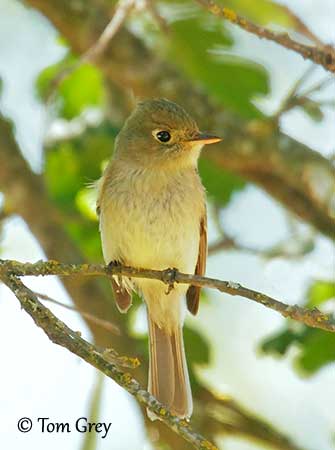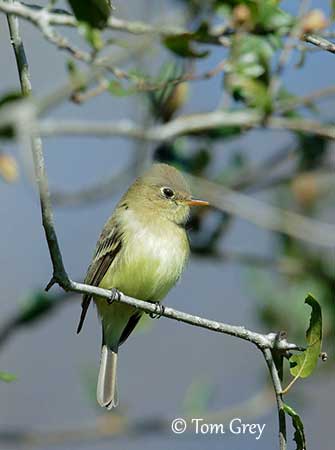
Fr: Moucherolle côtier
Ang: Pacific-slope Flycatcher
All: Feuchtwald-Schnäppertyrann
Esp: Mosquero del Pacífico
Ita: Pigliamosche del Pacifico
Nd: Oeverfeetiran
Sd: västempid
Photographer:
Tom Grey
Tom Grey's Bird Pictures & Tom Grey's Bird Pictures 2
Text by Nicole Bouglouan
Sources:
HANDBOOK OF THE BIRDS OF THE WORLD Vol 9 - by Josep del Hoyo - Andrew Elliot - David Christie - Lynx Edicions - ISBN: 8487334695
Animal Diversity Web (University of Michigan Museum of Zoology)
Bird Web (Seattle Audubon Society)
Biodiversity of the Central Coast
South Dakota Birds and Birding – (Terry L. Sohl)
What Bird-The ultimate Bird Guide (Mitchell Waite)
Wikipedia, the free encyclopaedia
Pacific-slope Flycatcher
Empidonax difficilis
Passeriformes Order – Tyrannidae Family
INTRODUCTION:
The members of the genus Empidonax show fairly similar structure and plumage pattern, but the differentiation occurs mainly through voice and behaviour. These birds are always difficult to identify.
There are differences also in habitat, nesting habits and distribution between birds with almost similar plumage characteristics.
Numerous Empidonax species are widespread in North and Middle America. Some of them have more restricted range.
The Pacific-slope Flycatcher is native to the coastal regions of W North America, from British Columbia and S Alaska to S Baja California. The northernmost populations migrate southwards after breeding.
It is replaced in the inland range by the Cordilleran Flycatcher (E. occidentalis), a very similar species also of genus Empidonax. Both were once considered the same species named Western Flycatcher, but following new studies, the species has split into two full species in 1989. However, they intergrade in areas where their ranges almost overlap. In winter, both species migrate S to Mexico, and there, they are really difficult to distinguish from one another. They are usually identified through their vocalisations and their morphology. The present species is smaller with smaller bill.

The Pacific-slope Flycatcher is usually found in moist, shaded areas, often shaded streams and coniferous forests. During winter, it frequents montane and tropical lowland evergreen forests in W and S Mexico. It feeds mainly on arthropods and occasionally fruit, berries and seeds, depending on the season. It hunts by sallying from perch and gleaning prey from the vegetation. It nests in an open cup-shaped structure placed in sheltered site, from tree fork or upturned roots to small bridges and other artificial places.
The Pacific-slope Flycatcher is described as common to fairly common and the species is not globally threatened.
DESCRIPTION OF THE BIRD:
Biometrics:
Length: 14-17 cm
Wingspan: 20-23 cm
Weight: 9-12 g
The Pacific-slope Flycatcher is a slim, small flycatcher with fairly large head and broad bill.
The upperparts are olive-green with the rump browner than the back. The wings are blackish-brown with strongly contrasting pale wingbars on median and greater coverts. Secondary and tertial flight-feathers have pale yellow edges. The narrow, dusky tail is fairly long.
The underparts are pale yellow but the breast is tinged olive and the belly is slightly paler.
In worn plumage, the upperparts appear greyer whereas the underparts are paler and more whitish. The wingbars are paler and narrower.
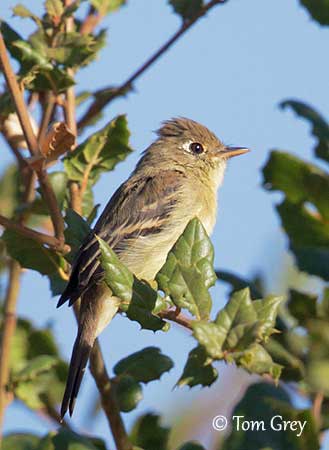
On the head, crown, ear-coverts and nape are olive-green and we can see a slightly bushy crest.
The two-tone broad bill has yellow to pale pink lower mandible and dark brown upper mandible. The bill is broad and straight. The eyes are dark brown, surrounded by white to dull yellowish teardrop-shaped eyering extending to a point behind the eye. Legs and feet are dark grey.
Male and female are similar.
The juvenile resembles adult but the wingbars are buffy to cinnamon and the upperparts are more brownish.
SUBSPECIES AND RANGE:
The Pacific-slope Flycatcher has three subspecies that vary in size and colour.
E.d. difficilis (described above) breeds from SE Alaska, S to S California (W to Sierra Nevada) and extreme NW Mexico (N Baja California). It winters in W Mexico.
E.d. insulicola breeds on Channel Islands, off S California. The winter range is unknown.
This race is larger and greyer, with longer bill and longer wings than the mainland races.
E.d. cineritius breeds in Cape District in S Baja California.
This one is the smallest, with duller greyish-brown back than nominate.
HABITAT:
The Pacific-slope Flycatcher breeds in humid coniferous forest, mixed conifer-deciduous woodland and dense second growth. It is closely related to shady, riparian habitats. It usually occurs from sea-level to 1,500 metres of elevation.
During winter in Mexico, it is found in mountainous conifer forest, tropical deciduous forest and also tropical lowland evergreen forest, between 1,000 and 3,500 metres of elevation.
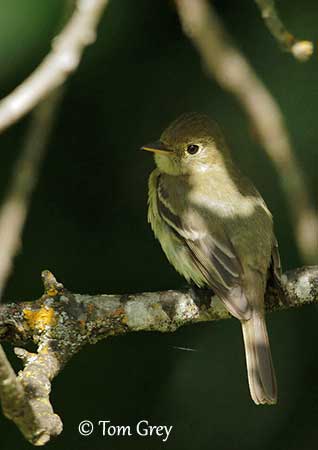
CALLS AND SONGS: SOUNDS BY XENO-CANTO
The voice is the only field mark to identify “difficilis” and “occidentalis”. The male Pacific-slope Flycatcher gives a one-syllabled up slurred whistle, whereas the Cordilleran Flycatcher utters a two-syllabled up slurred whistle.
Only the male sings to attract a female and to proclaim the territory. The song is described as “tséé-wee pttuck tseep” usually rapidly repeated. The dawn song is very similar “si ti-swéé pi-tik”.
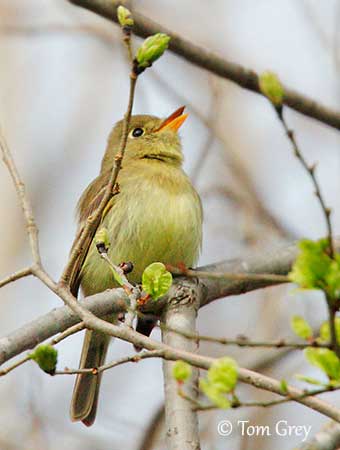
The male’s call is a single, strongly up-slurred note “pee-IST”, or “pe WEAP” or a rising whistle “pawee”. For information, the call of the Cordilleran Flycatcher is sharply two-syllabled with second note higher “pit-PEET”. This sound appears longer on sonograms.
The females of both species give a brief “tsit” or “tsip”.
During aggressive disputes, we can hear a harsh ‘chrrip” or “prrit”, and bill-snapping is also reported. During migration, the bird utters a soft “peet”. We can also hear other sounds such as “ti-ti-ti” and “weer-weet-weet” calls.
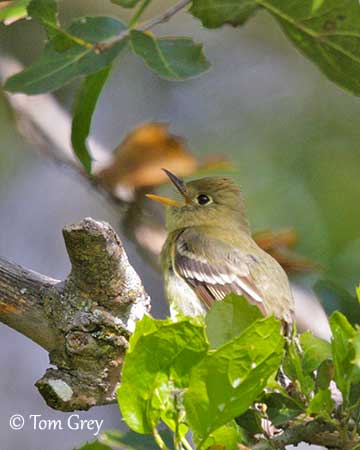
BEHAVIOUR IN THE WILD:
The Pacific-slope Flycatcher feeds mainly on insects such as Hymenopterans, Coleopterans, Hemipterans, Dipterans, Lepidopterans (adults and larvae), Cicadellidae and also spiders. It also consumes berries and seeds depending on the season.
It hunts from perch in the shady parts of the forest. It performs rapid sallies to catch insects in the air. Caterpillars and spiders are taken from foliage and twigs while hovering in front of the vegetation. It usually forages in mid to lower canopy of forest.
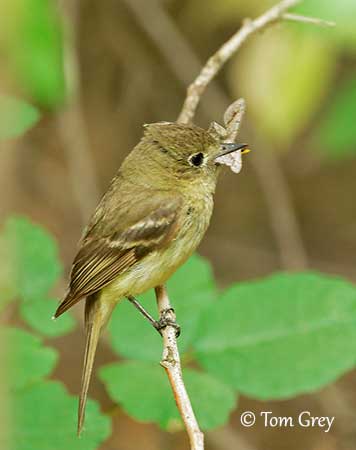
The Pacific-slope Flycatcher defends the territory by singing. This species is mainly monogamous, and polygamy is very rare. The female builds the cup-shaped nest in sheltered places such as upturned roots of fallen tree, under a bridge and others, both natural and artificial, often near or on the ground, but sometimes several metres above the ground. Both adults feed the chicks.
The Pacific-slope Flycatcher winters in Mexico and the population of S Baja California is resident. The migrating birds leave the breeding areas from late July to October, and they return from mid-April to mid-May.
Vagrants are recorded from the Gulf coast of USA and E North America.
The flight is weak and fluttering, with shallow wingbeats.
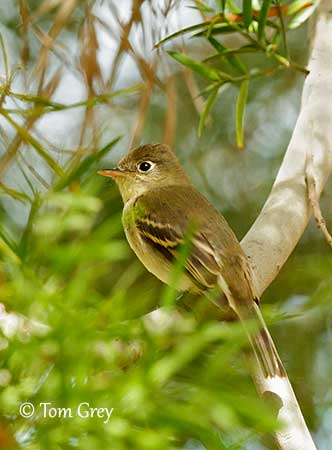
REPRODUCTION OF THIS SPECIES:
The breeding period occurs from mid-April to mid-July. This species may produce several broods per season.
The nest-site is on or near the ground. The female builds a cup-shaped structure with moss, grass, rootlets, strips of bark, lichens, leaves and spider webs. The cup is lined with softer material, often plant fibres, hair and/or feathers.
The nest may be built against a tree trunk, in a hollow made by lack of bark, or in upturned roots of a fallen tree, or in vertical stream bank, under a small bridge and other places. The nest is often higher when built in artificial structures, usually between 4 and 6 metres above the ground.
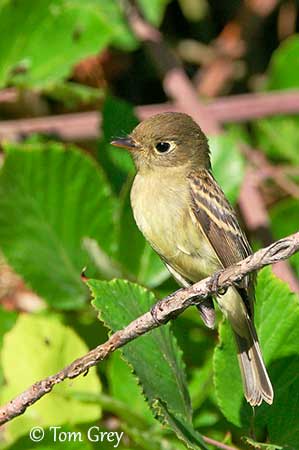
The female lays 3-4 whitish eggs with brown markings near the larger end. She incubates alone during 14-15 days. The chicks are fed by both parents. They are able to fly about 14-18 days after hatching, but they remain near the nest for a few days after fledging.
PROTECTION / THREATS / STATUS:
The Pacific-slope Flycatcher may be affected by deforestation in North West. However, this species is described as common to fairly common.
The global population is estimated to number 8,400,000 mature individuals (Partners in Flight – 2017).
Some declines may occur caused by habitat loss.
But currently, the species is not globally threatened, and Pacific-slope Flycatcher is evaluated as Least Concern.
